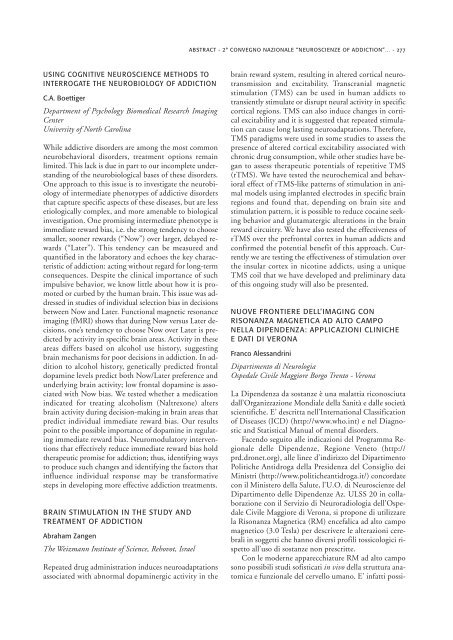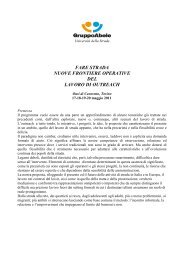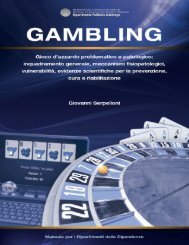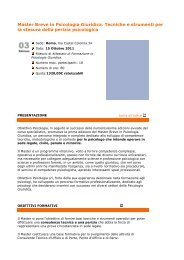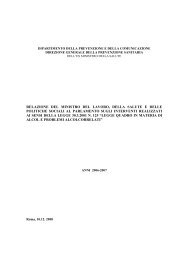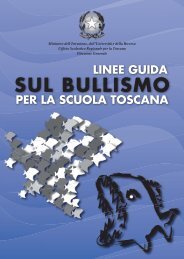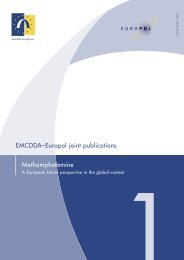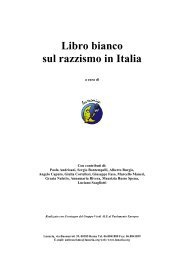Neuroscienze e dipendenze - Dipartimento per le politiche antidroga
Neuroscienze e dipendenze - Dipartimento per le politiche antidroga
Neuroscienze e dipendenze - Dipartimento per le politiche antidroga
You also want an ePaper? Increase the reach of your titles
YUMPU automatically turns print PDFs into web optimized ePapers that Google loves.
ABSTRACT - 2° CONVEGNO NAZIONALE “NEUROSCIENZE OF ADDICTION”… - 277<br />
USING COGNITIVE NEUROSCIENCE METHODS TO<br />
INTERROGATE THE NEUROBIOLOGY OF ADDICTION<br />
C.A. Boettiger<br />
Department of Psychology Biomedical Research Imaging<br />
Center<br />
University of North Carolina<br />
Whi<strong>le</strong> addictive disorders are among the most common<br />
neurobehavioral disorders, treatment options remain<br />
limited. This lack is due in part to our incomp<strong>le</strong>te understanding<br />
of the neurobiological bases of these disorders.<br />
One approach to this issue is to investigate the neurobiology<br />
of intermediate phenotypes of addictive disorders<br />
that capture specific aspects of these diseases, but are <strong>le</strong>ss<br />
etiologically comp<strong>le</strong>x, and more amenab<strong>le</strong> to biological<br />
investigation. One promising intermediate phenotype is<br />
immediate reward bias, i.e. the strong tendency to choose<br />
smal<strong>le</strong>r, sooner rewards (“Now”) over larger, delayed rewards<br />
(“Later”). This tendency can be measured and<br />
quantified in the laboratory and echoes the key characteristic<br />
of addiction: acting without regard for long-term<br />
consequences. Despite the clinical importance of such<br />
impulsive behavior, we know litt<strong>le</strong> about how it is promoted<br />
or curbed by the human brain. This issue was addressed<br />
in studies of individual se<strong>le</strong>ction bias in decisions<br />
between Now and Later. Functional magnetic resonance<br />
imaging (fMRI) shows that during Now versus Later decisions,<br />
one’s tendency to choose Now over Later is predicted<br />
by activity in specific brain areas. Activity in these<br />
areas differs based on alcohol use history, suggesting<br />
brain mechanisms for poor decisions in addiction. In addition<br />
to alcohol history, genetically predicted frontal<br />
dopamine <strong>le</strong>vels predict both Now/Later preference and<br />
underlying brain activity; low frontal dopamine is associated<br />
with Now bias. We tested whether a medication<br />
indicated for treating alcoholism (Naltrexone) alters<br />
brain activity during decision-making in brain areas that<br />
predict individual immediate reward bias. Our results<br />
point to the possib<strong>le</strong> importance of dopamine in regulating<br />
immediate reward bias. Neuromodulatory interventions<br />
that effectively reduce immediate reward bias hold<br />
therapeutic promise for addiction; thus, identifying ways<br />
to produce such changes and identifying the factors that<br />
influence individual response may be transformative<br />
steps in developing more effective addiction treatments.<br />
BRAIN STIMULATION IN THE STUDY AND<br />
TREATMENT OF ADDICTION<br />
Abraham Zangen<br />
The Weizmann Institute of Science, Rehovot, Israel<br />
Repeated drug administration induces neuroadaptations<br />
associated with abnormal dopaminergic activity in the<br />
brain reward system, resulting in altered cortical neurotransmission<br />
and excitability. Transcranial magnetic<br />
stimulation (TMS) can be used in human addicts to<br />
transiently stimulate or disrupt neural activity in specific<br />
cortical regions. TMS can also induce changes in cortical<br />
excitability and it is suggested that repeated stimulation<br />
can cause long lasting neuroadaptations. Therefore,<br />
TMS paradigms were used in some studies to assess the<br />
presence of altered cortical excitability associated with<br />
chronic drug consumption, whi<strong>le</strong> other studies have began<br />
to assess therapeutic potentials of repetitive TMS<br />
(rTMS). We have tested the neurochemical and behavioral<br />
effect of rTMS-like patterns of stimulation in animal<br />
models using implanted e<strong>le</strong>ctrodes in specific brain<br />
regions and found that, depending on brain site and<br />
stimulation pattern, it is possib<strong>le</strong> to reduce cocaine seeking<br />
behavior and glutamatergic alterations in the brain<br />
reward circuitry. We have also tested the effectiveness of<br />
rTMS over the prefrontal cortex in human addicts and<br />
confirmed the potential benefit of this approach. Currently<br />
we are testing the effectiveness of stimulation over<br />
the insular cortex in nicotine addicts, using a unique<br />
TMS coil that we have developed and preliminary data<br />
of this ongoing study will also be presented.<br />
NUOVE FRONTIERE DELL’IMAGING CON<br />
RISONANZA MAGNETICA AD ALTO CAMPO<br />
NELLA DIPENDENZA: APPLICAZIONI CLINICHE<br />
E DATI DI VERONA<br />
Franco A<strong>le</strong>ssandrini<br />
<strong>Dipartimento</strong> di Neurologia<br />
Ospeda<strong>le</strong> Civi<strong>le</strong> Maggiore Borgo Trento - Verona<br />
La Dipendenza da sostanze è una malattia riconosciuta<br />
dall’Organizzazione Mondia<strong>le</strong> della Sanità e dal<strong>le</strong> società<br />
scientifiche. E’ descritta nell’International Classification<br />
of Diseases (ICD) (http://www.who.int) e nel Diagnostic<br />
and Statistical Manual of mental disorders.<br />
Facendo seguito al<strong>le</strong> indicazioni del Programma Regiona<strong>le</strong><br />
del<strong>le</strong> Dipendenze, Regione Veneto (http://<br />
prd.dronet.org), al<strong>le</strong> linee d’indirizzo del <strong>Dipartimento</strong><br />
Politiche Antidroga della Presidenza del Consiglio dei<br />
Ministri (http://www.<strong>politiche</strong><strong>antidroga</strong>.it/) concordate<br />
con il Ministero della Salute, l’U.O. di <strong>Neuroscienze</strong> del<br />
<strong>Dipartimento</strong> del<strong>le</strong> Dipendenze Az. ULSS 20 in collaborazione<br />
con il Servizio di Neuroradiologia dell’Ospeda<strong>le</strong><br />
Civi<strong>le</strong> Maggiore di Verona, si propone di utilizzare<br />
la Risonanza Magnetica (RM) encefalica ad alto campo<br />
magnetico (3.0 Tesla) <strong>per</strong> descrivere <strong>le</strong> alterazioni cerebrali<br />
in soggetti che hanno diversi profili tossicologici rispetto<br />
all’uso di sostanze non prescritte.<br />
Con <strong>le</strong> moderne apparecchiature RM ad alto campo<br />
sono possibili studi sofisticati in vivo della struttura anatomica<br />
e funziona<strong>le</strong> del cervello umano. E’ infatti possi-


